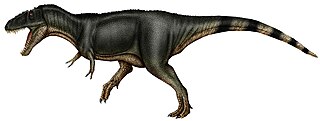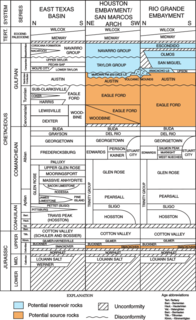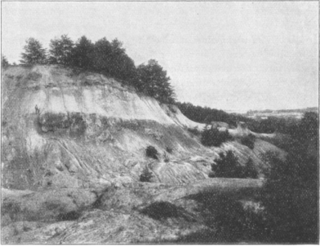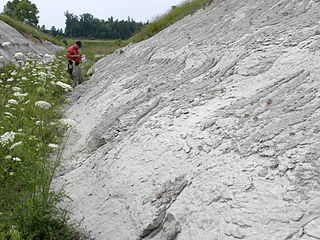
Labocania is a genus of carnivorous theropod, possibly tyrannosauroid, dinosaur from Baja California, Mexico, which lived 73 million years ago, in the Campanian stage of the late Cretaceous Period.

The Lance (Creek) Formation is a division of Late Cretaceous rocks in the western United States. Named after Lance Creek, Wyoming, the microvertebrate fossils and dinosaurs represent important components of the latest Mesozoic vertebrate faunas. The Lance Formation is Late Maastrichtian in age, and shares much fauna with the Hell Creek Formation of Montana and North Dakota, the Frenchman Formation of southwest Saskatchewan, and the lower part of the Scollard Formation of Alberta.
The Eagle Sandstone, originally the Eagle Formation, is a geological formation in Montana whose strata date back to the Late Cretaceous. It is a light to brownish gray to pale yellow-orange, fine-grained sandstone. It contains areas of crossbedding and local shale members. It contains large sandy calcareous concretions. Its thickness varies from 100 to 350 feet due to the lens nature of the individual sandstone layers and local interbedded sandy shale layers.
The Evanston Formation is a geological formation in Wyoming whose strata date back to the Late Cretaceous. Dinosaur remains are among the fossils that have been recovered from the formation. The fossil formation also has the remains of prehistoric mammals from the Paleocene epoch. Mammal fossils have been found in Paleocene rocks here too.
The Merchantville Formation is a geological formation in the northeastern United States whose strata date back to the Late Cretaceous, around the time of the Santonian and Campanian age. Dinosaur remains are among the fossils that have been recovered from the formation.
La Bocana Roja Formation is a geological formation in Baja California, Mexico whose strata date back to the Late Cretaceous. Dinosaur remains are among the fossils that have been recovered from the formation.

The Hensel Formation or Hensel Sand is a Mesozoic geologic formation in Texas. Fossil ornithopod tracks have been reported from the formation.
The Black Creek Group is a geologic group in North Carolina. It preserves fossils dating back to the Late Cretaceous period.

The Potomac Group is a geologic group in Delaware, Maryland, New Jersey, and Virginia. It preserves fossils dating back to the Cretaceous period. An indeterminate tyrannosauroid and Priconodon crassus, a nodosaurid, are known from indeterminate sediments belonging to the Potomac Group. The Potomac Group was initially believed to have been Late Jurassic in age by Othniel Charles Marsh but later studies, such as Clark (1897), have found that the Potomac Group is in fact Early-Late Cretaceous (Aptian-Turonian) in age.

The Prairie Bluff Chalk is a geologic formation in Alabama and Mississippi. It preserves fossils dating back to the Cretaceous period.
The De Queen Formation, formerly known as the DeQueen Limestone Member is a Mesozoic geological formation located in southwestern Arkansas and southeastern Oklahoma in the United States. Fossil sauropod and theropod tracks have been reported from the formation. It preserves fossils dating back to the Cretaceous period, particularly the Albian age.
The Benevides Formation is a geologic formation in Texas and Mexico. It preserves fossils dating back to the Cretaceous period.

The Escondido Formation is a geologic formation in Texas and Coahuila, Mexico. It preserves fossils dating back to the Late Cretaceous period.
The Cedar District Formation is a geologic formation exposed on Vancouver Island, the Gulf Islands of British Columbia and San Juan Islands of Washington (state). It preserves fossils dating back to the Campanian Epoch of the Cretaceous period. It dates to the lower mid-Campanian.
The Rosario Group is a Late Cretaceous geologic group in southwestern California and northwestern Baja California (Mexico). In older literature it was named Rosario Formation.

The Olmos Formation is a geologic formation in Mexico. It preserves fossils of plants, hadrosaurs, ceratopsians, tyrannosaurs and the turtle Palauchelys dating back to the Cretaceous period.

The Ferruginous Sands is a geologic formation in England. It preserves fossils dating back to the Aptian Stage of the Cretaceous period. It consists of "a number of heavily bioturbated coarsening-upward units each comprising dark grey sandy muds or muddy sands passing up into fine-to medium-grained grey to green glauconitic sands." The dinosaur Vectaerovenator inopinatus is known from the formation. Shark teeth are also known from the formation, including those of an indeterminate lamniform shark and Palaeospinax.
The Poudingue Ferrugineux is a geologic formation in France. It preserves fossils dating back to the Albian stage of the Cretaceous period. It predominantly consists of conglomerate, deposited in shallow marine conditions. It is exposed at Cap de la Hève at Le Havre, Normandy. The dinosaur Normanniasaurus is known from the formation.
The Rognacian Formation is a geologic formation in France. It is of Maastrichtian age. The mammal Valentinella is known from the formation, alongside indeterminate dinosaur remains.

Suskityrannus is a genus of small tyrannosauroid theropod from the Late Cretaceous in southern Laramidia. It contains a single species, Suskityrannus hazelae, believed to have lived roughly 92 million years ago. The type specimen was found in the Turonian-age Moreno Hill Formation of the Zuni Basin in western New Mexico.






